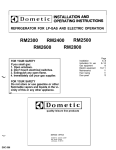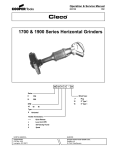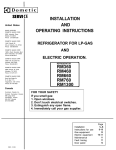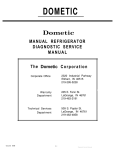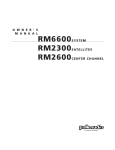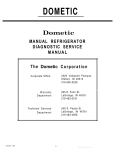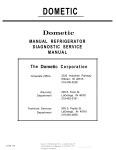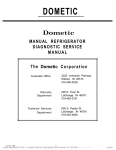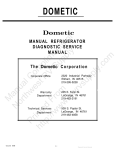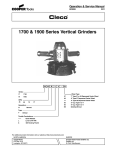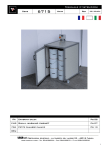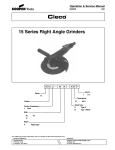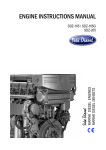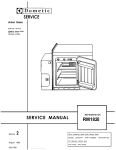Download RM2300 RM2400 RM2500 RM2600 RM2800 Installation
Transcript
REFRIGERATOR FOR LP-GAS AND ELECTRIC OPERATION RM2500 RM2400 RM2300 RM2800 RM2600 FOR YOUR SAFETY If you smell gas: 1. Open windows. 2. Don’t touch electrical switches. 3. Extinguish any open flame. 4. Immediately call your gas supplier. Installation Instructions for use Gas equipment Electric equipment Maintenance Fault tracing Door panel FOR YOUR SAFETY Do not store or use gasoline or other flammable vapors and liquids in the vicinity of this or any other appliance. mD emetic 1 quality leisure line products SERVICE OFFICE DOMETIC SALES CORP. 509 South Poplar LaGrange, IN 46761 DSC #308 I Page 5-8 9-10 10 10-11 11 11 12 REFRIGERATORS WITH PIE20 IGNITER RM2300/2400 -36 @;:aq\ 39 Fig.1 E 2 DCB A Item No. 1 2 3 4 7 9 10 11 14 23 26 27 29 30 31 33 Description Retainer Thermo electric safety valve Thermo couple element Coupling Thermostat Cut-off valve Nipple Nut Switch Lighter Burner Electrode Terminal Sealing ring Snap catch Burner housing 35 36 38 42 43 46 47 50 52 53 55 57 58 59 60 61 62 64 67 Burner retainer Terminal 12/120V Burner jet Plug Cover Cover Flue baffle Heater Bushing Retaining ring Flue top Light conductor Push rod Push rod Shaft, thenostat Shaff, switch Lead for 12V Flexible cord Clamping plate REFRIGERATORS WITH AUTOMATIC IGNITION RM2500 Fig.2 Item No. 1 2 3 4 7 9 10 11 14 23 26 27 29 30 31 33 Description Plug Thermo electric safety valve Thermo couple element Coupling Thermostat Cut-off valve Nipple Nut Switch Reigniter Burner Electrode Terminal block Sealing ring Snap catch Burner housing 36 36 43 46 47 50 51 52 53 55 57 59 60 61 62 64 Terminal block Burner jet Cover Cover Flue baffle Heater Bushing Clamping plate Flue top Label for 12V Burner retainer Push rod Shaft, thermostat Shaft, switch Lead for 12/120V Flexible cord 3 REFRIQERATORS WITH AUTOMATIC IQNITION RM2600 RM 2800 Fig.3 Item No. 2 3 4 7 9 10 11 14 23 24 29 31 32 33 36 36 Description Thermo electric safety valve Thermo couple element Coupling Thermostat Cut-off valve Nipple Nut Switch Reigniter Gas tube Terminal block Snap catch Burner Electrode Terminal block Burner jet 43 46 47 50 51 54 55 59 60 61 64 67 Cover Nipple Flue baffle Heater Nipple Flue cap Protection plate Push rod Shaft, thermostat Shaft, switch Flexible cord Burner housing INSTALLATION GENERAL INSTRUCTIONS This appliance is designed for storage of foods and storage of frozen foods and maklng ice. The refrigerators outlined hereon have been design certified under ANS 221.19 -- 1983. Refrigerators by the American Gas Association for installation in a mobile home or recreational vehicle and are appproved by the Canadian Gas Association. The certifications are, however, contingent on the installation being made in accordance with the following instructions as applicable. The installation must in the USA conform with: 1. National Fuel Gas Code ANSI Z223.1-1 984 2. Manufactured Home Construction and Safety Standard, Title 24 CFR, Pan 32-80, 3. Recreational Vehicles ANSI/NFPA No. 501 C-1977 The unit must be electrically grounded in accordance with the National Electric Code ANSI/NFPA No. 70-1984 when installed if an external alternating current electrical source is utilized. 4. Any applicable local code The installation must in Canada conform with 1. Current CGA B 149 Gas Installation Codes 2. Current CSA Standard Z 240.4 GAS - EQUIPPED RECREATIONAL VEHICLES AND MOBIL HOUSING 3. Any applicable local code ELECTRICAL CONNECTION 120VoltsAC The refrigerator is equipped with a three prong (grounded) plug for protection against shock hazards and should be plugged directly into a properly grounded three prong receptacle. Do not cut or remove the grounding prong from this plug. The cord should be routed to avoid coming in contact with the burner cover flue cover or other hot components. Refrigerator models requiring 12 V DC supply On units provided with interior light or automatic reigniter or both there is one additional terminal block marked “12 V”. On “Three Power” units with interior light or automatic reigniter or both there are two additional blocks. The refrigerator must be connected to the battery circuit with two wires of adequate capacity to avoid voltage drop. The wire gage should be chosen with consideration to the wire length in accordance with table below. The 12 V circuit must be fused. Maximum circuit fuse size: 15 Amps. for the models RM2300 and RM2400, 20 Amps. for RM2500, 30 Amps. for RM2600 and 40 Amps. for RM2800. Do not use the body or chassis of the vehicle as a substitute for either of the two conductors. No other electrical equipment or lighting should be connected to the refrigerator circuit. The refrigerator will draw from 10 to 23 Amps at 12 Volt depending on model. The interior light and the reigniter must be connected to a separate battery circuit and will draw about 1 Amp. Maximum two conductor wire length in feet and meter. The unit must be electrically grounded in accordence with the current CANADIAN ELECTRICAL CODE C 22 Parts 1 and 2. Ventilation The installation shall be made in such a manner as to separate the combustion system from the living space of the mobile home or recreational vehicle. Openings for air supply or for venting of combustion products shall have a minimum dimension of not less than 1/4 inch. Proper installation requires one lower fresh air intake and one upper exhaust vent. The ventilation kits shown in this instruction booklet have been certified for use with the refrigerator models listed in the tables. Certified vent system kits, see separate list. The ventilation kits must be installed and used without modification. An opening towards the outside at floor level in the refrigerator compartment must be provided for ventilation of heavier-than-air fuel gases. The lower vent of the recommended kits is provided with proper size openings. The flow of combustion and ventilating air must not be obstructed. For ready serviceability of the burner and control manifold parts of the refrigerator the lower side vent is fitted with a liftout panel which provides an adequate access opening. 6 ft. 4 ft. 69 64 110 102 49 79 34 55 31 50 135 220 CAUTION Do not Operate the refrigerator on 12 Volt when the vehicle is parked. YOU will run out of battery in a rather short time. If possible the installation of a 12 Volt operated refrigerator should be completed with a relay mounted either in the car or in the recreational vehicle (see below). This relay will automatically cut out the refrigerator when the car engine is stopped. GAS CONNECTION Hook-up to the gas supply line is accomplished at the manual gas valve, which is furnished with a 3/8" SAE (UNF 5/8- 18) male flare connection. All completed connections should be checked for leaks with soapy water. The gas supply system must incorporate a pressure regulator to maintain a supply pressure of not more than 11 inches water column. When testing the gas supply system at test pressures in excess of 1/2 psig the refrigerator and its individual shutoff valve must be disconnected from the gas supply piping system. When testing the gas supply system at pressures less or equal 1/2 psig the appliance must be isolated from the gas supply piping system by closing its individual manual shutoff valve. In case detailed instructions on the installation and connection to the gas supply are required, contact your dealer or distributor. 5 SPECIAL HINTS Note. Do not install the appliance directly on carpeting. Carpeting must be protected by a metal or wood panel beneath the appliance which extends at least full width and depth of the appliance. The refrigerator must be installed in a substantial enclosure and must be level. A spirit level is supplied with each refrigerator and by placing it in the freezer compartment one can level the refrigerator both ways front to back and side to side. When installing the refrigerator in the enclosure care should be taken to ensure a complete sealing between the front frame of the refrigerator and the top, sides and bottom of the enclosure. For this purpose a length of sealing strip is applied to rear surfaces of the front frame. A sealing strip should also be applied to the foremost floor of the enclosure as shown in fig 8. The sealing strip should provide a complete isolation of the appliance combustion system from the vehicle interior. Be careful not to damage the sealing strip applied to the floor of the enclosure when the refrigerator is put in place. In the front frame and in the base at the rear of the refrigerator there are holes for screws for fixing the refrigerator in the enclosure. See fig. 9. Any space between counter or storage area and the top of the refrigerator greater than 1 1/2" should be blocked. The heat produced at the rear of the refrigerator will otherwise become trapped in this space making the top of the refrigerator hot and reducing the efficiency of the refrigerator. Fig.8 TO REMOVE AND REPAIR THE REFRIGERATOR Before working on the refrigerator, make sure that 120 V A.C. and optional 12 V DC. Leads are disconnected. Close the gas valve. Unscrew the hexagon nut (#11 Fig. 2) and move the Valve on the gas line out of the bracket. Check that the valve slips out of the clip connection with the switch shaft. Loosen the screws fixing the refrigerator to the enclosure and remove the refrigerator. When replacing the refrigerator make sure that the sealing strips are properly positioned. After reassembly the gas connection should be checked for leaks. TEST OF THE GAS SAFETY SHUTOFF The gas safety shutoff device must be tested after the refrigerator is placed in operation. Refrigerator wlth piezo ignitor. (Figure 1) 1. Start the refrigerato;according to the instruction for gas operation with piezo igniter. 2. Check that the gas flame is lit. This can be observed through the reflector (E). 3. Close the gas valve by turning the knob (A) back to position “OFF”. 4. Wait 1 minute. 5. Remove cover plate, see (46) in fig 1. Open the gas valve by turning the knob (A) to position “GAS” without pushing the button (C) and (D). Test that no gas comes through the jet, (item 38.) Use soap water solution. Be careful not to damage the jet. 6. After test, rinse the jet with water. Once more be careful no to damage the jet. Assemble the cover plate. Start the refrigerator by following the instruction for gas operation with piezo igniter. Normal gas operation should now return. Operate for at least 5 minutes. Fig.9 Refrigerator with automatic reigniter. (Fig 2 & 3) Start the refrigerator according to the instruction for gas operation with automatic reigniter. Check that the gas flame is lit. The lamp (E) is out. Close the gas valve by turning the knob (A) back to position “OFF”. Wait 1 minute, disconnect 12 V D.C. Remove cover plate, see (46) fig. 2 for RM2500 and (55) fig. 3 for RM2600/2800. Open the gas valve by turning knob (A) to position “GAS” without pushing the button (C). The igniter will not spark. Test that no gas comes through the jet, (item 38). Use soapy water. Be careful not to damage the jet. 6. After the test rinse the jet with water. Once more be careful not to damage the jet. Assemble the cover plate. Connect the 12 V D.C. again. Start the refrigerator by following the instruction for gas operation with automatic reigniter. Normal gas operation should now return. Operate for at least 5 minutes. CERTIFIED INSTALLATION Certified installations require one roof vent and one lower side vent or as optional one upper vent and one lower side vent. The two alternatives are provided for by using the different kits listed in the Appendix. For further information contact your dealer or distributor. METHODS OF INSTALLATION Condenser The methods of installation are shown in figures 10 a and 10 b. It is essential that all maxlmum or minimum dimensions are strictly maintained as the performance of the refrigerator is dependent on an adequate flow of air over the rear of the refrigerator. VENTILATION -HEIGHTS Minimum ventilation heights in inches and mm Fig. 10 R M 2 3 0 0 in. 37 a 31 R M 2 4 0 0 in. 34 RM2500 in. 42 R M 2 6 0 0 in. 56 R M 2 8 0 0 in. 62 Duct cross section area 5"x18" Ventilation Condenser Fig. 10 b 7 CLEARANCES Minimum clearances in inches to combustible materials are G. Top 0 K. Side 0 L: Bottom 0 M: Rear 1 N: See example below Clearance M between the rearmost part of the refrigerator and the wall behind the refrigerator Clearance N on top of the condenser is related to the minimum ventilation height See Fig 11 and examples below Refrigerator Overall product dimensions model Height A 0 inch 30 3/8 Width B L Depth d Height H Width W Depth D Distance between top of condenser and top of refrigerator e Recess dimensions Installation product dimensions Depth C Height h Width W Fig.1 1 21 11/16 22 1/16 20 1/4 20 3/8 29 3/4 20 1/2 21 3/8 1 1/4 RM2400 inch 32 15/16 23 24 11/16 32 1/8 21 9/16 22 15/16 32 5/16 21 13/16 23 15/16 1 1/4 RM2500 inch 40 13/16 23 24 11/16 40 21 9/16 22 15/16 40 3/16 21 13/16 23 15/16 1 1/4 RM2600 0 inch 52 23 24 11/16 51 3/16 21 9/16 22 15/16 51 3/8 21 13/16 23 15/16 1 1/8 RM2800 0 inch 57 15/16 24 15/16 24 11/16 57 1/8 23 7/16 22 15/16 57 1/2 23 13/166 23 15/16 1 1/8 This method of installation and these clearences will give you adequate space for servicing and proper installation. View from above d T e h Fig.1 2 EXAMPLES The clearance N for the RM 2300 model is derived at in the following way. Installation with upper and lower side vents N= Minimum ventilation height 37 minus installation height 29 9/16 plus distance between condenser top and refringerator top 1 114 in: N=37-29 9/16+1 1/4=8 11/16 inches mm: N=940-751+32=221 mm Installation with roof vent and lower side vent N=Minimum ventilation height 31 minus installation height 29 9116 plus distance between condenser top and refrigerator top 1 114 plus distance between roof surface and roof vent cap 5 114 in: N=31 -29 9/16+1 1/4+5 1/4=7 15/16 inches mm: N=787-751+32+134=202 mm INSTRUCTIONS FOR USE HOW TO START THE REFRIGERATOR Leveling In the boiler, ammonia vapor is distilled from an ammonia-water mixture and carried to the finned condenser, where it liquifies. The liquid flows to the evaporator, where it creates cold by evaporating into a circulating flow of hydrogen gas. If the evaporator coil is not level the liquid readily accumulates, forming pockets which can impair the gas curculation or even block it, in which case, of course, the cooling will stop. When the recreational vehicle is stationary it must be leveled to be comfortable to live in. If the refrigerator is properly installed, the freezer shelf parallel to the floor, the refrigerator will then also perform properly. A bubble level should be placed on the freezer shelf. When the vehicle is in tow, the continuous rolling and pitching movement will not affect the refrigerator as long as the movement passes either side of level, but when the trailer is temporarily parked this sensitivity of the refrigerator should be remembered. So once more, before you start the refrigerator make sure the recreational vehicle is leveled to be comfortable to live in. Gas Operation with piezo igniter (Fig. 1) 1. 2. 3. 4. To start the refrigerator turn the knob (A) to position “GAS”. Turn the thermostat knob (B) a quarter of a turn from position “OFF”. Push the button (C) to stop and push the button (D) of the piezo igniter. The pushing has to be repeated until the gas is lit at the burner. This can be observed through the reflector(E). After the gas is lit keep the button (C) pushed for 10 seconds. Release the button and check through the reflector that the burner flame stays burning. If not, repeat the lighting procedure. To shut off the refrigerator turn the knob (A) to off position. Gas Operation with automatic reigniter (Fig. 2 & 3) 1. To start the refrigerator turn the knob (A) to 2. 3. position “GAS”. Lamp (E) comes on. Turn the gas thermostat knob (B) a quarter of a turn from position “OFF”. Press the button (C) to stop and keep it depressed. When lamp (E) goes out, wait 15 sec. and release button (C). If the lamp comes on again, repeat the procedure. If flame blows out, reignition will take place automatically. To shut off the refrigerator turn the knob (A) to off position. NOTE: After a replacement of the LP Gas bottles or a Ion period with refrigerator off, the gas Pme is likely to be filled with air. In such a case the lighting procedure has to be repeated until the air is pushed out of the line and the gas has reached the burner. Electric Operation (Fig. 1,2,3) Check that the 120 Volt plug is correctly connected to the main supply. When the refrigerator is equipped for 12 Volt D.C. operation the low voltage connection is made at the terminals marked at the rear of the refrigerator. 2. Turn the knob (A) to desired position for electric operation. 3. Turn the thermostat knob (B) a quarter of a turn from position “OFF”. To shut off the refrigerator turn the knob (A) to offposition. 1. HOW TO USE THE REFRIGERATOR Food Storage Compartment The food storage compartment is completely closed and unventilated, which is necessary to maintain the required low temperature for food storage. Consequently foods having a strong odor or those liable to absorb odors should be covered. Vegetables, salads, etc. should be covered to retain their crispness. The coldest positions in the refrigerator are underneath the cooling evaporator and at the bottom of the refrigerator, and the least cold positions are on the upper door shelves. This should be considered when different types of food are placed in the refrigerator. Defrosting Shut off the refrigerator. Empty the refrigerator, leaving the drip tray under the finned evaporator and the cabinet and freezer doors open. If desired, defrosting may be speeded up by filling the ice tray with hot water and placing it in the freezer. When the frost on the finned evaporator section has melted water will be collected in the drip tray. The drip tray should be emptied at regular intervals. When all frost is melted, empty the drip tray and dry the interior of the refrigerator with a clean cloth. Replace the drip tray and ice tray, replace all food stuffs and set the thermostat knob to its normal position. Frozen Food Storage Compartment The Flame Failure Safety Device The ice trays should be placed in direct contact with the freezer shelf for fastest ice making. Quick frozen soft fruits and ice cream should be placed in the coldest part of the compartment which is at the bottom of the aluminium liner or, in models with a shelf, on this or just below it. Frozen vegetables, on the other hand, may be stored in any part of the compartment. The compartment is not designed for the deep or quick freezing of foodstuffs. Meat or fish foods, whether raw or prepared, and provided they are pre-cooled in the refrigerator, can however, also be stored in the frozen food storage compartment. They can then be stored about three times as long as in the fresh food storage compartment. To prevent drying out, keep food in covered dishes, in plastic bags or wrapped in aluminum foil. The tip of the thermo-couple must reach in over two slots of the burner. To replace the thermocouple proceed as follows: 1. Remove the cover 2. Unscrew plug and pull thermocouple straight out. 3. Remove spring. 4. Pull out thermocouple sideways from burner housing. 5. Bend the new thermocouple to the same shape as the old one. 6. Reassemble in reverse order. Check that the tip has been correctly refitted in relation to burner. 7. Mount plug, taking care not to damage the threaded hole in the aluminum cap of the housing. The plug must be properly tightened to the valve housing to ensure good contact between the thermocouple and the magnetic coil within the housing. Ice Making Ice cubes can be made in the ice trays which should be filled with water to within 1/4" from the top. To release the ice cubes seize the tray with both hands and twist the tray. Cubes not required should be replaced in the tray. Refill the tray with water and replace the tray on the freezer shelf. Ice making is accelerated if the thermostat knob is turned to setting “MAX”. It is a good idea to do this a few hours before an anticipated need for ice but be sure to turn the knob back to normal setting when the ice is formed or the foodstuffs in the cabinet may become frozen hard. To Shut Off the Refrigerator To shut off the refrigerator turn the knob (A) to off position. If the cabinet is not in operation over a period of weeks, it should be emptied and cleaned and the door left ajar. Some models are provided with interior light, which comes on when the door is opened. To avoid discharging the battery, the light should be shut off. Use tape to close the switch or remove the lamp. The ice trays should also be dried and kept outside the cabinet. Cleaning To clean the interior lining of the refrigerator use lukewarm weak soda solution. The evaporator, ice trays and shelves must, however, be cleaned with warm water only. Never use strong chemicals or abrasives to clean these parts or the protective surface will be spoiled. It is important always to keep the refrigerator clean. The Thermostat The refrigerator is equipped with a thermostat which is regulated by turning the knob to different settings in order to obtain the desired controlled cabinet temperature. At OFF Under normal operating conditions the thermostat valve remains closed and the burner is running continuously at the by-pass rate, just enough to keep the burner lit. At MAX The thermostat valve remains open and the burner is running continuously at full gas rate. Lowest cabinet and freezer temperatures are obtained at this setting. Between these two extremes of the dial various controlled temperatures can be obtained, by turning the thermostat knob to a suitable position. The closer to MAX the lower the temperature. As soon as the required cold temperature inside the cabinet is reached, the thermostat cuts the burner main flame leaving the by-pass flame to keep the safety valve open. The Igniter The refrigerator is fitted either with a piezo igniter (see fig. 1) or an automatic reigniter (fig. 2 and 3) which does not normally need any maintenance. If the igniter does not work properly contact an authorized service center. Do not store explosive substances in the refrigerator lighter fluid, gasoline, ether I such as cigarette ” “ “ “ or the ” I FLAME FAILURE c--T SAFI ELECTRIC EQUIPMENT Cartridge heater The refrigerator is equipped also for electric operation. Many models are equipped for both 120 Volts A C and 12 Volts D C operation. The heat necessary for the operation of an absorption type cooling unit is supplied by an electric heater mounted in a pocket of the boiler system. To replace the heater, first of course check that the wall plug is disconnected. If the refrigerator is equipped for 12 Volts D.C. operation, make sure that the 12 V leads are disconnected. Then proceed as follows: GAS EQUIPMENT Flue Top and Baffle The flue baffle is suspended from the top and must be in position in the central tube of the cooling unit. 10 1. Remove the cover of the main control structure by loosening the two screws 2. Disconnect the heater leads 3. Pull off the metal hose 4. With a pair of pliers unfold the lug holding the lid of the boiler casing and open the lid 5. Remove some insulation wool so that the heater is accessible 6. Turn and lift the heater out of its pocket 7. Fit the new heater into the pocket and pull on the hose around the leads 8. Connect the leads and put on the plastic cover 9. Reset the insulation and close the lid of the boiler casing and liquides. Check the venting system. The flow of combustion and ventilating air must not be obstructed. Check the flue baffle that it is clean and reasonably free from soot. Heavy soot formation indicates improper functioning of the burner. Clean baffle and flue. Further, clean cooling unit and floor under refrigerator. The entire gas installation should be checked for leaks at intervals. Test all pipe connections with a soap and water solution, not with an open flame. The Switch NOTE: Any service of the gas controls, with exception of above mentioned replacement, maintenance and cleaning operations must be performed by an authorized service center only. The electric control also comprises an on-off switch operated by the selector knob at the front panel. The switch has two “on”positions, one for 120 Volts A C (ELEC.) and one for 12 Volts D C operation. Note: Avoid water spraying through the refrigerators vents while washing your RV. The Thermostat The electric thermostat is combined with the gas thermostat and is thus operated by the knob (B) at the front panel. The temperature in the refrigerator can be regulated by turning the thermostat knob. Although the exact setting is not critical choose a setting at which the frost that gradually forms on the cooling evaporator is just maintained in dry condition. It will be necessary to turn the thermostat knob closer to MAX when the ambient temperature becomes higher or the load unusually heavy. If less cooling is required a lower setting should be chosen. FAULT TRACING The refrigerator does not freeze satisfactorily Causes and remedies a) Jet orifice clogged. Unscrew jet and blow clear or wash in alcohol. Do not use wire or pin to clean orifice. b) Check the leveling of the refrigerator. PERIODIC MAINTENANCE NOTE. Before working on the refrigerator make sure that 120 V A. C. and optional 12 V D. C. leads are disconnected. Shutoff gas valve. The Burner and the Burner Jet The color of the flame should be clear blue over the slots of the burner. Once or twice a year depending on use, it is necessary to clean and adjust the burner assembly. Proceed as follows: 1 Loosen screw and remove cover plate for burner housing. 2 Disconnect lighter cable from the electrode. 3 Loosen burner fixing screw and withdraw burner. 4 Clean burner tube with a brush. Blow withcompressed air. 5 Unscrew jet and clean with alcohol. Blow with compressed air. Never use a needle or similar instrument to clean jet. 6 Reassemble. 7 Be careful that the end of the burner fits into the slot on the bracket. The slots of the burner must be centrally located under the boiler tube. The Electrode For a proper ignition function it is necessary to keep the electrode insulation dry and free from dirt. The gap between burner tube and electrode shall be max. 3/16” (5 mm) and min. 1/8" (3 mm). WARNING If the refrigerator is used intermittently it should be checked at least once a year. It is important to keep the appliance area clear and free from combustible materials, gasoline and other flammable vapors c) Flame has gone out. Remedy: 1) Gas in bottle is us- d) e) f) g) h) i) j) k) ed up. 2) Tip of the thermocouple is not heated enough by flame. 3) Clogged by-pass screw - clean or exchange it. Air circulation around cooling unit is restricted. Be sure that refrigerator is properly ventilated. The evaporator is heavily coated with frost. Defrost. Flue baffle not inserted into the central tube of the cooling unit. The thermostat is incorrectly used. See paragraph on thermostat. In hot weather the setting should be closer to MAX than usual. Gauze in burner head clogged. Clean. Burner damaged. Replace. Burner may be dislocated. Relocate. Wrong gas pressure at the burner. Have pressure checked at burner and at gas bottle. Pressure at burner must not fall below 11 ” W.G. when thermostat is set on MAX. ODOR FROM FUMES Causes and remedies The flame touches side of the boiler due to dislocation of the burner. Relocate. Burner dislocation may also cause smoke and discoloring of walls and ceiling. Burner damaged. Replace. The flame touches flue baffle. Remedy: 1) Burner damaged. Replace. 2) Flue baffle too low. Correct the position of the baffle. The flue tube is dirty. Clean flue as follows: Cover burner and jet. Remove flue top and baffle. Clean flue with special flue brush. Clean baffle before putting back in place. All the above instructions are to be followed closely. The refrigerator is quality-guaranteed. However, we are not responsible for any failures caused by improper adjustments and unfavorable installation conditions. Contact service point or distributor service dept. for assistance. Replacement Parts Suppliers: See cover. 11 INSTRUCTIONS FOR MOUNTING THE DOOR PANEL The refrigerator is normally delivered without door panel(s). Before starting the mounting work check that the panel dimensions are in compliance with those given in the table and read the instructions through. When mounting the panel, proceed as follows. A. Remove the door decoration list (2) with its two screws (1). The upper corners of the upper panel (2door models) and the lower comers of the lower panel has to be cut according to the sketch. B. Insert one of the vertical edges of the panel into the groove of the door frame (3). C. Rend the panel gently so that the free side of the panel can be slipped into the corresponding groove of the door frame (4). D. Push the panel downwards so that the lower horizontal edge of the panel is fitted into the bottom groove (5). E. Between the upper edge of the panel and the door frame there is now a gap which should be covered by the decoration strip. F. Put the strip across the door so that the gap is covered and push it upwards (6). The tabs on the inside of the strip should fit in behind the flange of the door frame. Secure the decoration strip by means of the two screws (1). Panel dimensions Thickness max. 4 mm 5/32 inches REFRIG. MODELS HEIGHT + 1- 1/32 inch WIDTH +1- 1/32 inch RM2366 25 1/2 21 1/16 RM2400 28 1/16 22 13/32 RM2500 35 15/16 22 13/32 RM2600 upper lower 12 11/16 32 7/8 22 13/32 22 13/32 RM2800 upper lower 15 1/2 35 15/16 24 9/32 24 9/32 TO CHANGE THE DOOR OPENING FROM LEFT TO RIGHT OR VICE VERSA Open the door and unscrew the two screws holding the top front cover. The screws are accessible from beneath. Remove the top hinge pin and lift out the door. The lower pin for the refrigerator door should be shifted to the opposite side. The door can then be remounted. Before the top front cover is refitted check that the door closes easily and that the gasket seals well on all sides. 12 -a 1












